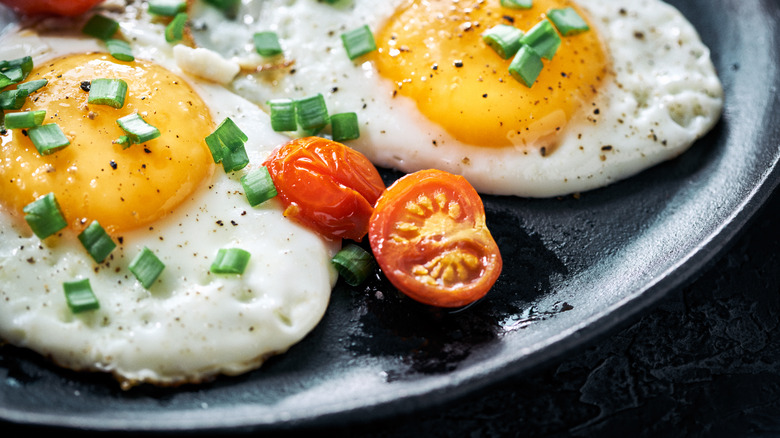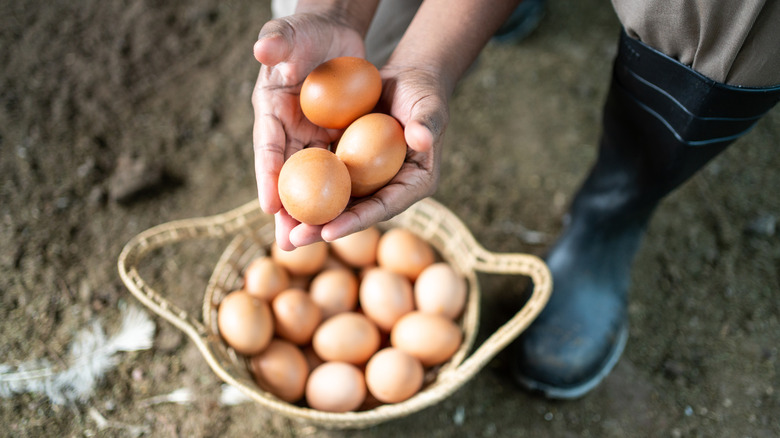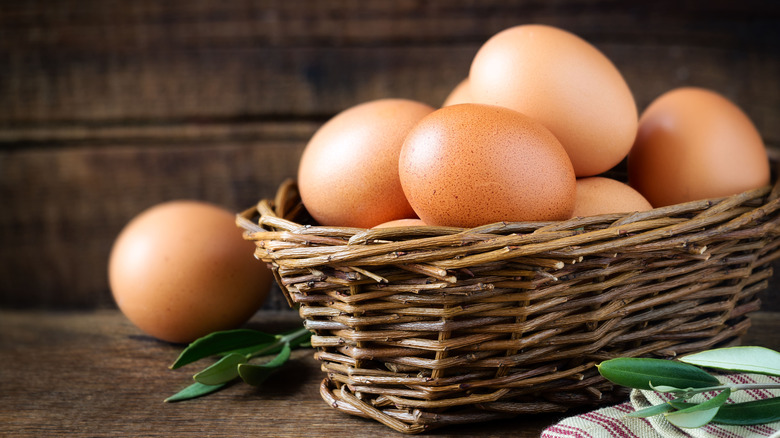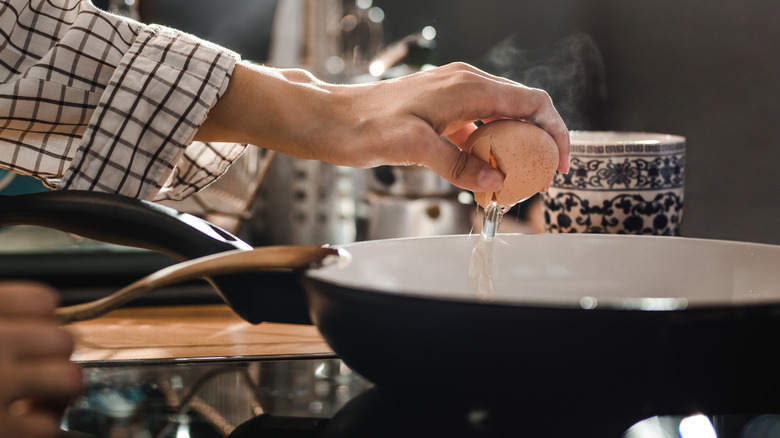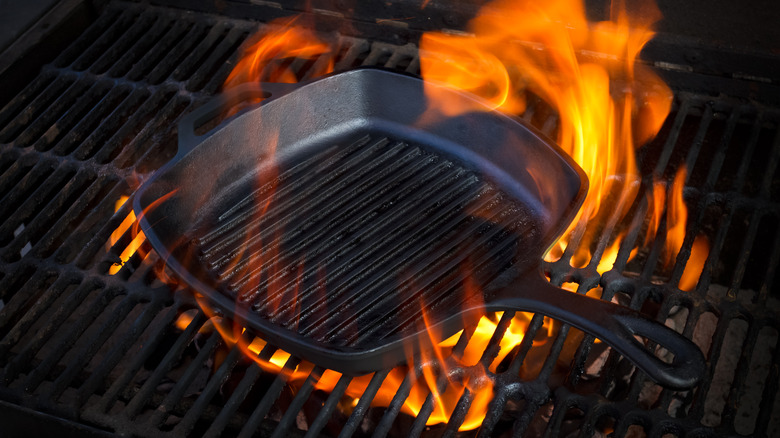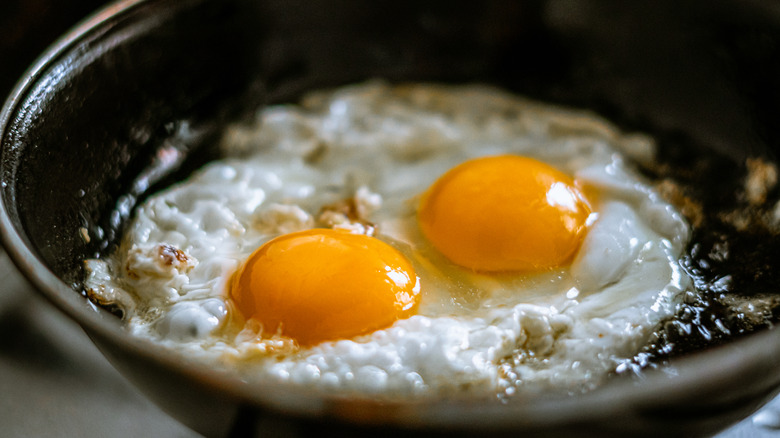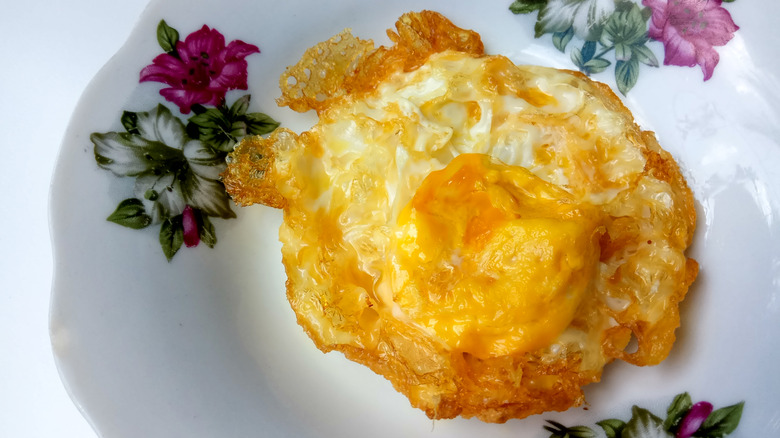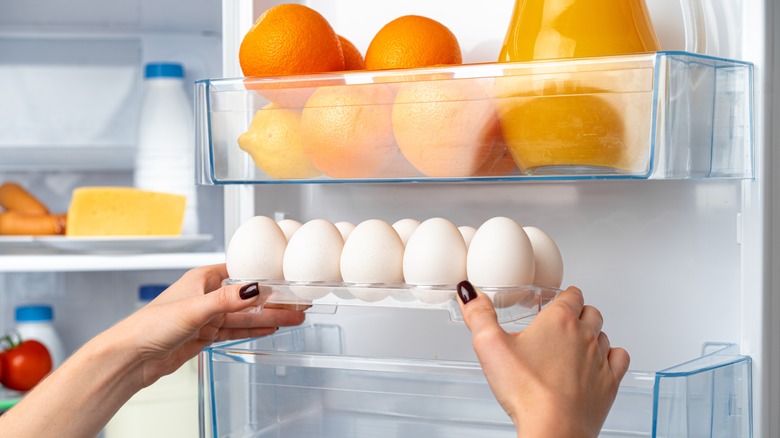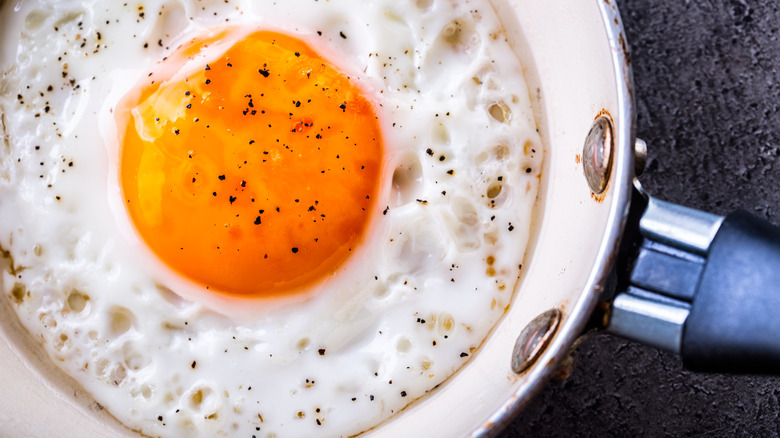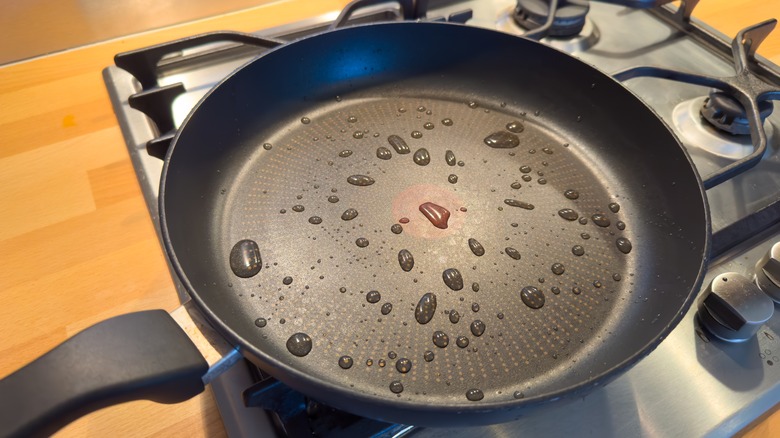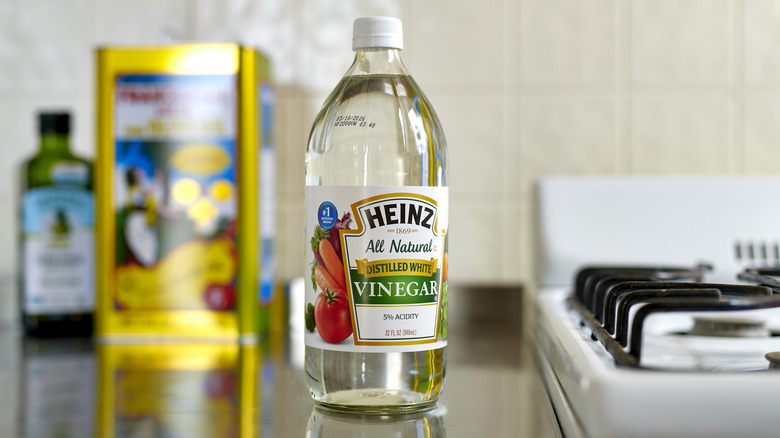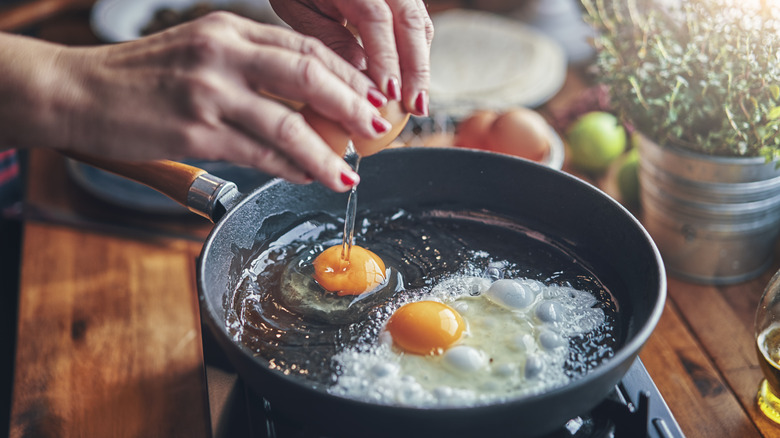11 Common Mistakes That Are Ruining Your Fried Eggs
Most people have looked into the fridge at least once and wished that something, anything easy and tasty would just jump out at them and magically cook itself. Ideally, such a dish cooks fast and consists of ingredients that most people keep on hand at all times.
Enter fried eggs. While they don't cook themselves, they come pretty close. They also up-level just about any dish. For example, turning them into more than a simple late-night snack is as easy as adding some mayo to bread to create a satisfying sandwich. Fried eggs also pack a punch in a bowl of ramen in a way that few ingredients can. And because of their flexibility, they qualify as one food that everyone should know how to make before they leave home for college. Not only are they easy on a college student's budget, but also, fresh eggs are easy to find in store aisles, even for the most novice of cooks.
But despite their ubiquity and flexibility, some problems do arise for inexperienced fried egg chefs. Cooked the wrong way, fried eggs can burn quickly, break easily, and can even turn slightly rubbery during the cooking process. All of these issues arise out of common mistakes that occasionally trip up even the best home cooks. The 11 examples in this post shed light on what these common mistakes are and more importantly, a few ideas on how to correct them.
1. Using not-so-fresh eggs
Because eggs are inherently runny, it's difficult to comprehend that some of the mistakes you make frying eggs make them even runnier, but it's true. Cooking with days-old eggs counts among the most obvious examples. When you cook with not-so-fresh eggs, the whites have already started to break down, making them runnier. Ditto for the yolks, once the aging process commences. Aside from the physical breakdown of the eggs, the difference in taste becomes apparent when you compare fresh eggs to old eggs.
On the label, the sell-by date typically represents 30 days after the eggs go into the package. The packaging date isn't the date that the hens laid the eggs, which means your store-bought eggs are probably much older than you think. Some store eggs could be up to 60 days old. You can eat them for another nine weeks or so after the package date, but yuck. Who wants to eat a six-month-old egg on the last day of its intended shelf life, particularly if you don't know when its shelf life began?
To get the freshest eggs possible from the store, look in the back of the egg fridge. Older stock is rotated to the front to ensure that the oldest eggs get sold first. The freshest eggs are behind those at the back of the cooler.
2. Not cracking the eggs on a flat surface
Celeb chef Anthony Bourdain had a hard, fast rule about where to break open a raw egg, and here's a hint, it wasn't the edge of the bowl since the days you started cracking eggs in a bowl to make cookies when you were a kid. He insisted that egg breaking should always take place on a flat surface, like a cutting board or a counter. While some could argue that this came as a result of a personality quirk, this wasn't the case, as lovable and quirky as Chef Bourdain was at times.
Even when you're not making cookies but just frying up some eggs, cracking the eggs on the counter instead of over the bowl is just a good practice. Breaking eggs on the edge of a bowl opens up the possibility that you will need to fish bits of egg shells out of the eggs in the bowl because it's difficult to predict how the shells will shatter on the bowl's or skillet's edge. If you've ever gotten bits of shell in your cookie dough or egg skillet, you've experienced this phenomenon firsthand. That's why Bourdain insisted that eggs should be cracked open on a flat surface. It cuts down on the bits of shells that end up in the bowl and cuts down on the bits of shells that chunk off in the process of cooking in general.
3. Cracking the egg directly into the pan
Want to know the best way to prevent crunchy fried eggs? Not cracking your eggs open on the edge of the skillet is a good start. Even under the best of circumstances, eggshell bits drop off into the eggs when you crack your eggs on the edge of the pan.
The most effective way to ensure a quality textural experience when eating fried eggs is to crack the eggs on a hard surface and then deposit them into a separate bowl or cup. Once they're in the cup, you then pour them into the frying pan when you're ready to cook them. And any shell bits that still cling to the egg, despite your best efforts to prevent eggshell bits, get trapped in the secondary bowl. You need only to dig it out with a spoon before slipping the cracked eggs into the skillet. It's definitely easier to remove shells from the secondary bowl than from the hot skillet. It's all eggs, no shell bits in the frying pan with this approach.
There's another more aesthetic benefit to doing this. If you're cooking for a crowd and the look of the dish is important, cracking the eggs into the secondary bowl allows you to do away with eggs that have broken open completely during the cracking process. Catching the egg in the bowl gives you the chance to ensure the egg is intact before it goes into the frying pan.
4. Letting the pan get too hot too soon
If you've lived long enough, you've acquired some food nerd truisms. For example, the best-tasting pasta usually comes from water you've salted first. Learning how to properly fry an egg is another one that food nerds have a lot of truism for. One of the most common ones suggests that proper egg frying begins with a very hot pan, right from the get-go. Turns out this truism isn't so true after all. Sure, a very hot pan cooks the egg on the bottom. On the top, you end up with clear and runny egg white Jello. Nearly every cook has experienced this at one time or another.
Starting with a cool pan and some olive oil offers you a better way to go. Here's why. Once you pour a couple of teaspoons of the olive oil in, you drop the egg on top of the oil and only then do you turn up the heat to medium. As the pan heats up, the egg's edges will cook, keeping the egg intact and picture-perfect. In this case, butter won't work as a frying oil. This technique works because you're topping the oil with the cracked raw egg from the get-go, and butter doesn't turn to oil until it's cooked. If you think you'll miss the butter flavor in your fried eggs, look at this as a good excuse to eat toast with lots of butter along with your eggs.
5. You don't baste your eggs
Basting is the act of pouring hot water, or on occasion, oil onto food during the cooking process. This cooking trick is what home cooks use to keep the Thanksgiving turkey from drying out. But it isn't just meats that benefit from basting. Fried eggs do, too, and if making fried eggs has been the bane of your existence because you just can't get them right, basting your eggs is your way out. However, in this case, you don't baste to keep the egg moist as much as you do it to ensure the top of the egg, including the yolk, gets properly cooked.
Here's how basting fried eggs works. Add butter or oil to the pan. Drop the raw egg into the skillet. Once the egg has begun to cook for about 30 to 45 seconds, add a teaspoon or two of water to the pan and then cover it with a lid for about a minute. The lid will keep the steam trapped inside and cook the top of the egg. You also have the option of using your spoon as a ladle and ladling some of the water or hot oil on top of the egg to baste it.
Finally, if you like to cook with butter but don't want a lot of butter fat, basting the egg in a combo of water and butter allows you to keep some of the butter flavor, without all the fat.
6. Overcooking your fried eggs
Overcooked eggs happen for a number of reasons, most of which don't include little gremlins who come and steal your attention way just long enough for your eggs to burn to a dark brown crisp. What usually happens is you can't get the top of the eggs to cook, so you leave them on longer than you should. (Pro tip here: Covering the pan with a lid often cures runny-topped eggs.) Or you underestimate how long it takes to make certain types of eggs, like over medium or over hard. And sometimes, if you're a novice, it may come down to not knowing how long to cook your eggs, period.
Truth be told, three or four minutes ought to be enough for over-easy once the pan warms up. It'll take you about five minutes for medium eggs, and six minutes to achieve hard egg yolks. Anything over those amounts of time results in overcooked, sometimes burnt eggs.
Of course, some of this comes down to learning some egg-cooking hacks, too, meaning that if you have difficulty with over easy, for example, it may take some practice to learn how to do it right. The good news is egg-flation has gone down so eggs run cheap these days in most stores. If you mess up a few on the way to learning how to become an eggs-ordinaire egg cook, chalk it up to the dues you have to pay as you learn how to cook fried eggs.
7. Cooking eggs straight from the fridge
Nothing drags down your Sunday morning breakfast eggy jam quite like eggs pulled from the frigid fridge right before you toss said eggs into the pan to cook. In this scenario, if your pan really started to heat up, the temperature in the skillet is going to take a nosedive back down to warm, at minimum. If your pan had barely reached the warm stage before you added the egg from the icebox, the temperature in the pan is likely to be back near the starting line from a heat standpoint.
That's why savvy cooks never take an egg directly from the fridge and toss it into the fire. They allow it to sit out on the counter for about 30 minutes or so until the eggs reach room temperature. By allowing the eggs to warm up to room temperature, the issues that you've had with the fluctuating heat levels in the pan disappear. Often home gourmands don't know that the pan's temperature has cooled down. Instead, they only get evidence that it has. That is to say, they end up with unevenly cooked eggs.
If you're concerned about leaving the eggs out on the counter for too long, make a note of this. You can leave them out of the fridge for up to two hours before they hit the danger zone and the salmonella start to set up house inside your eggs's pretty pearly white shells.
8. Not seasoning the egg correctly
In principle, seasoning your eggs should not present you with difficulty. A little salt. A little pepper. Maybe some garlic, white pepper, or paprika. And you're good to go. Mostly, this is true, but seasoning eggs is kind of an art. If you get it wrong, at best, you get a pucker face as a big bite of seasoning hits your tongue all at once. At worst, breakfast gets dumped in the trash.
Good fried egg seasoning technique allows you to infuse the egg with seasonings deep into the egg whites, flavoring each bite. Many people season their eggs after cooking ends and before eating begins. While it's okay to add salt and pepper here, too, if you must, this approach often produces inelegant, in-your-face results. Often, all you taste is seasoning and not so much the egg because the seasoning sits on top.
Here's the best way to describe your seasoning goal. If your egg's seasoning tastes like it's naturally a part of the egg, as if the hen herself added seasoning to the egg before she dropped it, then you've done seasoning correctly. Weirdly, often the best way to make this happen is to add seasoning to the oil instead or at least, in addition to, the egg. Basting the egg on top of this technique finishes things off nicely. The seasoning coats the egg evenly, giving you subtle flavors in each bite, without you over-seasoning the egg in the process.
9. Opting out of the non-stick pan route
Even if you were to opt for hard-boiled instead of fried eggs, it's impossible to deny how delicate eggs actually are. And there's certainly no denying their delicate natures when you fry them. The threat of them tearing apart looms ever-present as you cook them. Over time, people have resorted to a number of solutions to prevent this. Adding oil to the pan counts as the one that has stood the test of time throughout the centuries. However, once non-stick pans came onto the scene, the danger of shrapneling your eggs to bits in the pan dramatically decreased.
In some cases, it's even possible to fry your eggs in a non-stick pan without even an iota of cooking spray and have them not stick. It all comes down to cooking them on medium heat as opposed to high heat since high heat increases your chances of getting stick-to-the-pan eggs and as a result, broken eggs. When you cook eggs on high heat in a non-stick pan with a bit of cooking spray, removing the egg from the flame and covering it with a lid until cooking is done is often the trick to getting an unbroken egg.
When you're looking for a non-stick pan, go for a pan that's made from either smooth ceramic or Teflon. Short of cooking your eggs in the microwave, these tools mean the difference between having eggs that stick to the bottom of the pan or not.
10. Leaving vinegar out of the cooking process
Experienced egg chefs know that a dash of white vinegar splashed into poached egg water sets the whites of the eggs faster than just about any other trick. This trick isn't so much a trick as it is chemistry. Acid, in this case from the vinegar, changes the structure of the protein. When added to raw eggs, the whites stay put instead of spreading to the outer edges of the pan like wildfire on the grassy plains.
This miracle of egg cooking comes about thanks to a process called denaturing. Essentially, through denaturing, the protein in the egg whites breaks down. This, in turn, causes the whites to become solid. Cooking them does this, but so does a dash or two of vinegar. But vinegar does more than just solidify eggs. Depending on the type of vinegar, eggs become tastier in the process.
And as it turns out, adding vinegar to eggs isn't just for poached eggs. It works magically for fried eggs, too. Creative applications of the technique are welcome, with many being variations on basting fried eggs, except instead of basting them in water or oil, they get a vinegar-and-water bath. If you fry your eggs in olive oil or butter, you also have the option of cooking the eggs to your preference until they're nearly done and then adding a bit of wine vinegar to the mix for some tangy egg-solidifying flavor.
11. Using the wrong size of pan
Pan size matters when you cook fried eggs. For example, a skillet that's too large encourages the whites of the eggs to spread from California to Maine. This doesn't present so much of an issue if you're making four or five eggs. The pan, then, is plenty large to accommodate all those egg whites without overcrowding the pan. Everything gets evenly cooked. However, for making one or two eggs, using such a large pan means eggs with whites so thin, they qualify as crepes.
It's difficult to handle such eggs in the pan without breaking them apart because the whites aren't condensed enough to fit on the spatula when you flip the eggs. Inevitably, the whites break apart mid-flip because the whites have spread too far, hanging over the side of the spatula, and often sliding off it in the process. A small pan works better here, and not just because the egg whites don't spread out. They also cook more evenly because the stove's heat isn't used up heating parts of the pan that won't cook anything.
That's really what it comes down to when you're looking for the right pan to cook your fried eggs in. You want even heat distribution throughout. Fitting the pan size to the size of the job goes a long way to ensuring that this happens. In both cases, too small or overcrowded, you're looking at food that's cooked unevenly at best and sloppily at worst.
